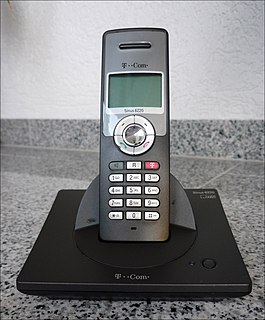The Digital Private Network Signalling System (DPNSS) is a network protocol used on digital trunk lines for connecting to PABX. It supports a defined set of inter-networking facilities.
In telecommunications, RS-232 or Recommended Standard 232 is a standard originally introduced in 1960 for serial communication transmission of data. It formally defines signals connecting between a DTE such as a computer terminal, and a DCE, such as a modem. The standard defines the electrical characteristics and timing of signals, the meaning of signals, and the physical size and pinout of connectors. The current version of the standard is TIA-232-F Interface Between Data Terminal Equipment and Data Circuit-Terminating Equipment Employing Serial Binary Data Interchange, issued in 1997. The RS-232 standard had been commonly used in computer serial ports and is still widely used in industrial communication devices.
The Session Initiation Protocol (SIP) is a signaling protocol used for initiating, maintaining, and terminating communication sessions that include voice, video and messaging applications. SIP is used in Internet telephony, in private IP telephone systems, as well as mobile phone calling over LTE (VoLTE).
In computer networking, the User Datagram Protocol (UDP) is one of the core communication protocols of the Internet protocol suite used to send messages to other hosts on an Internet Protocol (IP) network. Within an IP network, UDP does not require prior communication to set up communication channels or data paths.
In computing, a handshake is a signal between two devices or programs, used to, e.g., authenticate, coordinate. An example is the handshaking between a hypervisor and an application in a guest virtual machine.

X.25 is an ITU-T standard protocol suite for packet-switched data communication in wide area networks (WAN). It was originally defined by the International Telegraph and Telephone Consultative Committee in a series of drafts and finalized in a publication known as The Orange Book in 1976.

In computing, a serial port is a serial communication interface through which information transfers in or out sequentially one bit at a time. This is in contrast to a parallel port, which communicates multiple bits simultaneously in parallel. Throughout most of the history of personal computers, data has been transferred through serial ports to devices such as modems, terminals, various peripherals, and directly between computers.
Transport Layer Security (TLS) is a cryptographic protocol designed to provide communications security over a computer network. The protocol is widely used in applications such as email, instant messaging, and voice over IP, but its use in securing HTTPS remains the most publicly visible.
A Controller Area Network is a robust vehicle bus standard designed to allow microcontrollers and devices to communicate with each other's applications without a host computer. It is a message-based protocol, designed originally for multiplex electrical wiring within automobiles to save on copper, but it can also be used in many other contexts. For each device, the data in a frame is transmitted serially but in such a way that if more than one device transmits at the same time, the highest priority device can continue while the others back off. Frames are received by all devices, including by the transmitting device.
Direct Client-to-Client (DCC) is an IRC-related sub-protocol enabling peers to interconnect using an IRC server for handshaking in order to exchange files or perform non-relayed chats. Once established, a typical DCC session runs independently from the IRC server. Originally designed to be used with ircII it is now supported by many IRC clients. Some peer-to-peer clients on napster-protocol servers also have DCC send/get capability, including TekNap, SunshineUN and Lopster. A variation of the DCC protocol called SDCC, also known as DCC SCHAT supports encrypted connections. An RFC specification on the use of DCC does not exist.
Client-to-client protocol (CTCP) is a special type of communication between Internet Relay Chat (IRC) clients.

The RapidIO architecture is a high-performance packet-switched electrical connection technology. RapidIO supports messaging, read/write and cache coherency semantics. Based on industry-standard electrical specifications such as those for Ethernet, RapidIO can be used as a chip-to-chip, board-to-board, and chassis-to-chassis interconnect.

The Gateway Control Protocol is an implementation of the media gateway control protocol architecture for providing telecommunication services across a converged internetwork consisting of the traditional public switched telephone network (PSTN) and modern packet networks, such as the Internet. H.248 is the designation of the recommendations developed by the ITU Telecommunication Standardization Sector (ITU-T) and Megaco is a contraction of media gateway control protocol used by the earliest specifications by the Internet Engineering Task Force (IETF). The standard published in March 2013 by ITU-T is entitled H.248.1: Gateway control protocol: Version 3.

ITU-T Recommendation Q.931 is the ITU standard ISDN connection control signalling protocol, forming part of Digital Subscriber Signalling System No. 1. Unlike connectionless systems like UDP, ISDN is connection oriented and uses explicit signalling to manage call state: Q.931. Q.931 typically does not carry user data. Q.931 does not have a direct equivalent in the Internet Protocol stack, but can be compared to SIP. Q.931 does not provide flow control or perform retransmission, since the underlying layers are assumed to be reliable and the circuit-oriented nature of ISDN allocates bandwidth in fixed increments of 64 kbit/s. Amongst other things, Q.931 manages connection setup and breakdown. Like TCP, Q.931 documents both the protocol itself and a protocol state machine.
In software architecture, a messaging pattern is an architectural pattern which describes how two different parts of an application, or different systems connect and communicate with each other. There are many aspects to the concept of messaging which can be divided in the following categories: hardware device messaging and software data exchange. Despite the difference in the context, both categories exhibit common traits for data exchange.
Real-Time Messaging Protocol (RTMP) is a communication protocol for streaming audio, video, and data over the Internet. Originally developed as a proprietary protocol by Macromedia for streaming between Flash Player and the Flash Communication Server, Adobe has released an incomplete version of the specification of the protocol for public use.
H.239 is an ITU-T recommendation from the H.32x Multimedia Communications' macrofamily of standards for multimedia communications over various networks.

H.323 is a recommendation from the ITU Telecommunication Standardization Sector (ITU-T) that defines the protocols to provide audio-visual communication sessions on any packet network. The H.323 standard addresses call signaling and control, multimedia transport and control, and bandwidth control for point-to-point and multi-point conferences.

WebSocket is a computer communications protocol, providing full-duplex communication channels over a single TCP connection. The WebSocket protocol was standardized by the IETF as RFC 6455 in 2011. The current API specification allowing web applications to use this protocol is known as WebSockets. It is a living standard maintained by the WHATWG and a successor to The WebSocket API from the W3C.
The GB/T charging standard is a set of standards for electric vehicle AC and DC fast charging used in China. It consists of a series of GB/T standards, primarily in the GB/T 20234 family, revised and updated most recently in 2015 by the Standardization Administration of China.